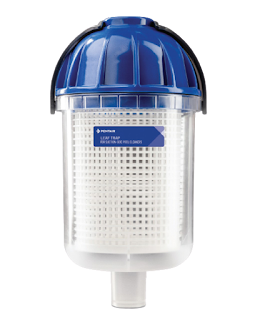The Pentair Leaf Trap 360476 is Pentair’s first smaller capacity Leaf Trap and one that has many great features. Pentair kept this leaf canister simple and easy to use and if you have a suction side cleaner this may be the perfect canister for you.
I always recommend a leaf canister of some type for your suction side cleaner. I would not run any suction side cleaner without a leaf canister just because I have seen pool skimmer lines and pumps clogged up with debris that is picked up by the cleaner. A leaf canister will prevent this and also prevent the pool from losing suction since the pump basket will stay clear allowing for maximum flow.
Here is more about the 360476 leaf canister:
To
keep suction-side cleaners working at top efficiency without stopping to open
and
clean the pump strainer basket, use a Pentair Leaf Trap.
Pentair Leaf Traps capture leaves and other debris poolside, where it’s easy to see, open and clean.
They are also simple to install and use, as their canisters
open and close easily.
Features:
Captures
leaves and debris before they can clog and cut flow at the pump strainer basket
or filter, maintaining optimum cleaning power
Leaf
Trap canisters are easy to open and clean for fast, easy debris removal
2.2-liter
cleaning capacity for longer times between cleanings
No
tools are needed, so it’s easy to install
One
male and one female hose attachment with no need for adapters
Connects
to 1-1/2" pool vacuum hoses
Pentair
360476
If you are comparing the 360476 to Pentair’s larger R Leaf canister it is like apples to oranges. The R211084 186A is 5 liters so it is over twice as large. It also features a fine mesh bag which I would suggest looking at if your pool has very fine debris. The plastic insert of the new 360476 will let very fine debris through so it is best to use the R211084 instead in that case.
If your pool has mainly larger leaf debris I suggest the 360476 because of the simple and easy-open lid. It is amazingly easy to open. The snap lid of the larger leaf trap can be harder to open over time and you will love emptying the 360476. Simply pull down on the grey handle and it opens. It couldn’t be easier and is far better than the Hayward version of this small canister.
My one hope is that the clear plastic will hold up to the sun UV rays, unlike the larger R211084 which tends to get cloudy and impossible to see through as it ages. The plastic does look thinner so I am thinking that issue will not present itself.
Overall if you are looking for a smaller leaf canister with a super to open lid that is made by a well-known brand such as Pentair, the 360476 leaf canister would be a great choice.
Visit
my Website: http://www.swimmingpoollearning.com/
eBook:
https://www.swimmingpoollearning.com/swimming-pool-care-ebook
YouTube
Video Index: http://poolmandave.blogspot.com/2014/03/swimming-pool-tips-reviews-how-to-video.html
– A list of all of my videos.

